
Moon shows earth-like tectonic activity
- Select a language for the TTS:
- UK English Female
- UK English Male
- US English Female
- US English Male
- Australian Female
- Australian Male
- Language selected: (auto detect) - EN
Play all audios:

New satellite data from Indian's moon mission Chandrayaan-1 has revealed a good amount of historic tectonic activity on the lunar surface, very similar to that on Earth . Scientists
studying geological processes on the lunar surface now report faults and grabens in partially and completely shadowed crater interiors of the lunar polar regions. Saumitra Mukherjee of the
School of Environmental Sciences at Delhi's Jawaharlal Nehru University along with colleague Priyadarshini Singh investigated data from the microwave sensor (MiniSAR) of the
Chandrayan-1 satellite using the image analysis software ENVI. "The geological processes on the moon are marked with various tectonic features suggestive of similar geological activity
occurring on the Earth," Mukherjee told _Nature India_. He said the tectonic activity could have been generated by cosmic rays and solar wind flux variability coupled with some interior
tectonic activity and meteorite impacts. Previous studies investigating lunar tectonic activity primarily used optical data. Mukherjee and Singh's study focused on the identification
of features indicating the presence of faults, lineaments and fractures on the lunar topography. They confirm that partially and completely shadowed crater interiors in the polar regions of
the Moon could also contain unique features indicative of tectonic activity. Data from the Mini-SAR imaging radar onboard Chandrayaan-1 mission is primarily used to identify signatures
suggesting the possibility of the presence of water ice within the completely shadowed regions of the lunar poles. This data has been used to view various other geological features such as
melt flows, crater ejecta blankets and secondary craters. Therefore, identification of distinct morphological features in shadowed as well as illuminated regions of lunar surfaces can be
easily done using mini-SAR data. "The SAR technology can also penetrate the surface and therefore is an effective tool to look for hidden fault lines in the shadowed portions on the
lunar regolith," Mukherjee says. Some other distinct surface and subsurface geological features have also been identified with Mini-SAR, which can further help study the process of
impact cratering as well as formation of secondary features that develop after the impact. With the present study of structural geological information on the surface of the Moon, the team
has a fair idea of present and past tectonic activities on the satellite. "These structural features are comparable with the features of the Earth. Presence of solid masses of water has
also been inferred within the volcanic craters," Mukherjee adds. The fresh knowledge of tectonic activity will help future manned and unmanned lunar investigations and to earmark
suitable areas for landing on the Moon.
